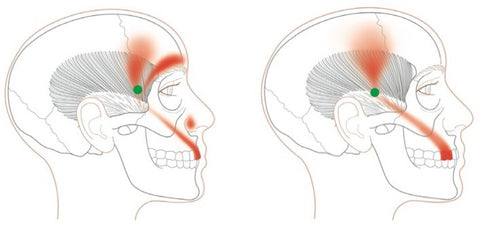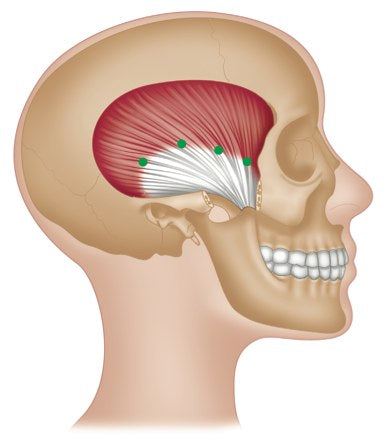Trigger Point Therapy - Treating Temporalis
The neck, face, and head muscles are as important to global muscle function as the core
The temporalis and masseter are synergists. An overdeveloped upper trapezius can be an overlooked contributor to problems associated with these muscles.
A short temporalis leads to teeth clenching, which can damage the sensitive proprioceptive covering on the teeth.
Temporal dysfunction can ensue, with loss of balance, vertigo, nausea, hearing difficulties, tinnitus, trigeminal neuralgia, and optical problems. Habits such as chewing gum can cause repetitive stress and strain.
One must appreciate the chain effect that an inhibited masseter could have on this muscle.
The temporalis and masseter may develop myofascial trigger points in an effort to provide much-needed tension.
A forward-head posture is most likely the evident posture
Pain passes upward and over the forehead on the ipsilateral side. Pain spills over just above the ear and into the nuchal line of the occiput.
The temporalis should be considered in all headache patients. Pain in the upper or lower teeth and gums is the most common pain pattern with this muscle.
A deep pain is typically reported over the eyebrow and occasionally into the same side and back of the head.
The treatment of other muscles on the basis of their pain referral patterns, if associated with this area, should also be carried out as part of the myokinetic chain.
ORIGIN
Temporal fossa, including parietal, temporal, and frontal bones. Temporal fascia.
INSERTION
Coronoid process of mandible. Anterior border of ramus of mandible.
ACTION
Closes jaw. Clenches teeth. Assists in side to side movement of mandible.
NERVE
Anterior and posterior deep temporal nerves from the trigeminal V nerve (mandibular division).
BASIC FUNCTIONAL MOVEMENT
Chewing food.

Temporalis - Common Referred Pain Patterns

Temporalis - Common Referred Pain Patterns

Temporalis Common Trigger Point Sites
These are areas where trigger points typically form and are shown for guidance only. Trigger points may form almost anywhere within the muscle and will always need to be identified through palpation.
REFERRED PAIN PATTERNS
Upper incisors and supraorbital ridge. Maxillary teeth and mid-temple pain. TMJ and mid-temple pain. Localized (backward and upward).
INDICATIONS
Headache, toothache, TMJ syndrome, hypersensitivity of teeth, prolonged dental work, eyebrow pain, headaches, bruxism, sinusitis pain, trismus (lockjaw), tingling in cheek area.
CAUSES
Chewing gum, tooth grinding/ bruxism, prolonged dental work, stress, emotional tension, jaw/ bite alignment, nail biting, thumb sucking.
DIFFERENTIAL DIAGNOSIS
Temporalis tendonitis. Polymyalgia rheumatica. Temporal arteritis, or giant cell arteritis (GCA).
CONNECTIONS
Upper trapezius, SCM, masseter.
BITE PLATES/BLOCKS/ OCCLUSAL SPLINTS
Opinion varies as to efficacy, type, and duration of use for occlusal devices. An evidence base suggests they can be beneficial.
POSTURE
Head forward or upper crossover patterns can be treated by a range of manual and trigger point therapies.
ADVICE FOR PATIENTS
Avoid gum chewing or hard substance chewing. Tongue position. Air conditioning in car/at work. Correct the head-forward posture. Stretch.
COMMONLY APPLIED TREATMENT TECHNIQUES
| Deep Stroking Massage | No |
| Compression | Yes |
| Muscle Energy | Yes |
| Positional Release | Yes |
| Spray and Stretch | No |
| Dry Needling | No |
| Wet Needling | No |
SELF HELP
Self-massage techniques can be helpful. Balls and pressure tools may be used, as the muscles are superficial.
GENERAL ADVICE TO CLIENTS
Avoid high-heeled/ at shoes. Regular stretching with hot and/or cold. Strapping/ankle support. Use of heel wedges and/or orthotics. Posture and gait advice. Examine shoes.
This trigger point therapy blog is intended to be used for information purposes only and is not intended to be used for medical diagnosis or treatment or to substitute for a medical diagnosis and/or treatment rendered or prescribed by a physician or competent healthcare professional. This information is designed as educational material, but should not be taken as a recommendation for treatment of any particular person or patient. Always consult your physician if you think you need treatment or if you feel unwell.
About Niel Asher Education
Niel Asher Education (NAT Global Campus) is a globally recognised provider of high-quality professional learning for hands-on health and movement practitioners. Through an extensive catalogue of expert-led online courses, NAT delivers continuing education for massage therapists, supporting both newly qualified and highly experienced professionals with practical, clinically relevant training designed for real-world practice.
Beyond massage therapy, Niel Asher Education offers comprehensive continuing education for physical therapists, continuing education for athletic trainers, continuing education for chiropractors, and continuing education for rehabilitation professionals working across a wide range of clinical, sports, and wellness environments. Courses span manual therapy, movement, rehabilitation, pain management, integrative therapies, and practitioner self-care, with content presented by respected educators and clinicians from around the world.
Known for its high production values and practitioner-focused approach, Niel Asher Education emphasises clarity, practical application, and professional integrity. Its online learning model allows practitioners to study at their own pace while earning recognised certificates and maintaining ongoing professional development requirements, making continuing education accessible regardless of location or schedule.
Through partnerships with leading educational platforms and organisations worldwide, Niel Asher Education continues to expand access to trusted, high-quality continuing education for massage therapists, continuing education for physical therapists, continuing education for athletic trainers, continuing education for chiropractors, and continuing education for rehabilitation professionals, supporting lifelong learning and professional excellence across the global therapy community.

Continuing Professional Education
Looking for Massage Therapy CEUs, PT and ATC continuing education, chiropractic CE, or advanced manual therapy training? Explore our evidence-based online courses designed for hands-on professionals.


















